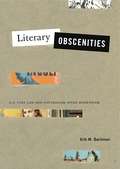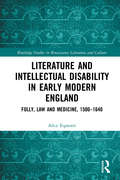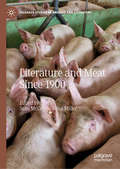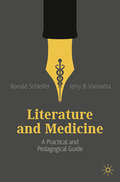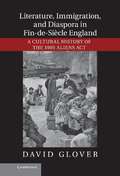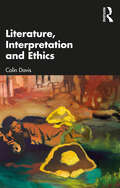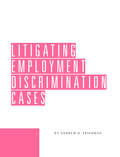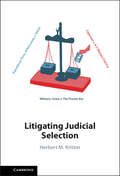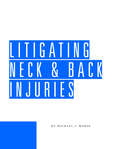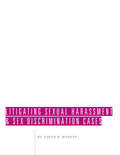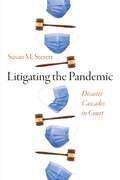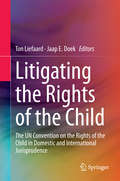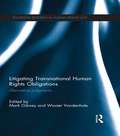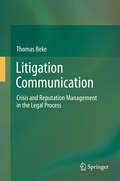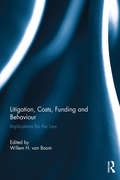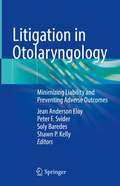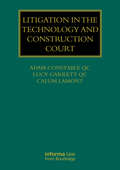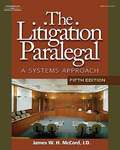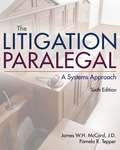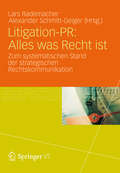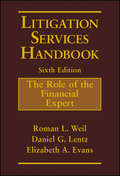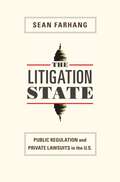- Table View
- List View
Literary Obscenities: U.S. Case Law and Naturalism after Modernism (Refiguring Modernism #25)
by Erik M. BachmanThis comparative historical study explores the broad sociocultural factors at play in the relationships among U.S. obscenity laws and literary modernism and naturalism in the early twentieth century. Putting obscenity case law’s crisis of legitimation and modernism’s crisis of representation into dialogue, Erik Bachman shows how obscenity trials and other attempts to suppress allegedly vulgar writing in the United States affected a wide-ranging debate about the power of the printed word to incite emotion and shape behavior.Far from seeking simply to transgress cultural norms or sexual boundaries, Bachman argues, proscribed authors such as Wyndham Lewis, Erskine Caldwell, Lillian Smith, and James T. Farrell refigured the capacity of writing to evoke the obscene so that readers might become aware of the social processes by which they were being turned into mass consumers, voyeurs, and racialized subjects. Through such efforts, these writers participated in debates about the libidinal efficacy of language with a range of contemporaries, from behavioral psychologists and advertising executives to book cover illustrators, magazine publishers, civil rights activists, and judges.Focusing on case law and the social circumstances informing it, Literary Obscenities provides an alternative conceptual framework for understanding obscenity’s subjugation of human bodies, desires, and identities to abstract social forces. It will appeal especially to scholars of American literature, American studies, and U.S. legal history.
Literatur und Recht: Formen und Prozesse gegenseitiger Vergegenständlichung (Literatur und Recht #1)
by Eric Achermann Andreas Blödorn Corinna Norrick-Rühl Petra PohlmannLiteratur hat nicht selten Recht als ihren Gegenstand, und Recht regelt Literatur auf vielfältige Weise. Diese gegenseitige Vergegenständlichung, zusammengefasst unter dem Begriff der „Materialität“, geschieht in verschiedenen Formen und erfüllt unterschiedliche Funktionen. Daraus ergibt sich eine Fülle von Fragen zur normativen Qualität des Rechts und zu den kulturellen Reflexionsleistungen der Literatur. Der Band fragt daneben auch konkreter nach der Rechtsförmigkeit des Fiktiven, der narrativen Ordnung von Rechtstexten, der historischen Wandelbarkeit des Verhältnisses von Recht und Literatur oder den rechtlichen Bedingungen des Buchmarktes.Dies ist ein Open-Access-Buch.
Literature and Intellectual Disability in Early Modern England: Folly, Law and Medicine, 1500-1640 (Routledge Studies in Renaissance Literature and Culture)
by Alice EquestriFools and clowns were widely popular characters employed in early modern drama, prose texts and poems mainly as laughter makers, or also as ludicrous metaphorical embodiments of human failures. Literature and Intellectual Disability in Early Modern England: Folly, Law and Medicine, 1500–1640 pays full attention to the intellectual difference of fools, rather than just their performativity: what does their total, partial, or even pretended ‘irrationality’ entail in terms of non-standard psychology or behaviour, and others’ perception of them? Is it possible to offer a close contextualised examination of the meaning of folly in literature as a disability? And how did real people having intellectual disabilities in the Renaissance period influence the representation and subjectivity of literary fools? Alice Equestri answers these and other questions by investigating the wide range of significant connections between the characters and Renaissance legal and medical knowledge as presented in legal records, dictionaries, handbooks, and texts of medicine, natural philosophy, and physiognomy. Furthermore, by bringing early modern folly in closer dialogue with the burgeoning fields of disability studies and disability theory, this study considers multiple sides of the argument in the historical disability experience: intellectual disability as a variation in the person and as a difference which both society and the individual construct or respond to. Early modern literary fools’ characterisation then emerges as stemming from either a realistic or also from a symbolical or rhetorical representation of intellectual disability.
Literature and Meat Since 1900 (Palgrave Studies in Animals and Literature)
by Seán McCorry John MillerThis collection of essays centers on literary representations of meat-eating, bringing aesthetic questions into dialogue with more established research on the ethics and politics of meat. From the decline of traditional animal husbandry to the emergence of intensive agriculture and the biotechnological innovation of in vitro meat, the last hundred years have seen dramatic changes in meat production. Meat consumption has risen substantially, inciting the emergence of new forms of political subjectivity, such as the radical rejection of meat production in veganism. Featuring essays on both canonical and lesser-known authors, Literature and Meat Since 1900 illustrates the ways in which our meat regime is shaped, reproduced and challenged as much by cultural and imaginative factors as by political contestation and moral reasoning.
Literature and Medicine: A Practical and Pedagogical Guide
by Ronald Schleifer Jerry B. VannattaLiterature and Medicine: A Practical and Pedagogical Guide is designed to introduce narrative medicine in medical humanities courses aimed at pre-medicine undergraduates and medical and healthcare students. With excerpts from short stories, novels, memoirs, and poems, the book guides students on the basic methods and concepts of the study of narrative. The book helps healthcare professionals to build a set of skills and knowledge central to the practice of medicine including an understanding of professionalism, building the patient-physician relationship, ethics of medical practice, the logic of diagnosis, recognizing mistakes in medical practice, and diversity of experience. In addition to analyzing and considering the literary texts, each chapter includes a vignette taken from clinical situations to help define and illustrate the chapter’s theme. Literature and Medicine illustrates the ways that engagement with the humanities in general, and literature in particular, can create better and more fulfilled physicians and caretakers.
Literature, Immigration, and Diaspora in Fin-De-SièCle England
by David GloverThe 1905 Aliens Act was the first modern law to restrict immigration to British shores. In this book, David Glover asks how it was possible for Britain, a nation that had prided itself on offering asylum to refugees, to pass such legislation. Tracing the ways that the legal notion of the 'alien' became a national-racist epithet indistinguishable from the figure of 'the Jew', Glover argues that the literary and popular entertainments of fin de siècle Britain perpetuated a culture of xenophobia. Reconstructing the complex socio-political field known as 'the alien question', Glover examines the work of George Eliot, Israel Zangwill, Rudyard Kipling and Joseph Conrad, together with forgotten writers like Margaret Harkness, Edgar Wallace and James Blyth. By linking them to the beliefs and ideologies that circulated via newspapers, periodicals, political meetings, Royal Commissions, patriotic melodramas and social surveys, Glover sheds new light on dilemmas about nationality, borders and citizenship.
Literature, Interpretation and Ethics
by Colin DavisLiterature, Interpretation and Ethics argues for the centrality of hermeneutics in the context of ongoing debates about the value and values of literature, and about the role and ethics of literary study. Hermeneutics is the endeavor to understand the nature of interpretation, as it poses vital questions about how we make sense of works of art, our own lives, other people and the world around us.The book outlines the contribution of hermeneutics to literary study through detailed accounts of role of interpretation in the work of key thinkers such as Martin Heidegger, Hans-Georg Gadamer, Paul Ricoeur, Umberto Eco, Jacques Derrida and Emmanuel Levinas. It also illustrates problems of interpretation posed by specific literary texts and films, emphasising how our interpretive acts also entail ethical engagements. The book develops a ‘hermeneutics of (guarded) trust’, which calls for attention to the agency of art without surrendering critical vigilance.Through a series of forays into theoretical texts, literary works and films, the book contributes to contemporary debates about critical practice and the cultural value. Interpretation, it suggests, is always fallible but it is also essential to our place in the world, and to the importance of the humanities.
Litigating Employment Discrimination Cases
by Andrew FriedmanLitigating Employment Discrimination Cases Most employment discrimination books deliver black-letter law and omit strategies, pitfalls, and forms. Andrew H. Friedman's Litigating Employment Discrimination Cases takes a more practical approach. Focusing on evaluation, discovery, summary judgment, and mediation, this affordable strategic guide delivers proven tactics, pattern arguments, common mistakes, and model forms for experienced plaintiff and defense lawyers. The book's collection of over 180 forms includes: * Engagement letters * Complaints * Demand letters * Deposition outlines * Pattern interrogatories * Requests for production * Mediation briefs and letters * Settlement agreements * Juror questionnaires * Motions in limine Litigating Employment Discrimination Cases is packed with pattern arguments supported by thousands of recent cases with parentheticals and pinpoint citations, pleadings, motions, discovery documents, deposition outlines, pitfalls to avoid, and, most importantly, practice-proven tactics and techniques. Some of the areas covered include: Discovery * Defending employer's efforts to interview the plaintiff. * Controlling ancillary proceedings. Summary judgment * Summary judgment oriented deposition tips for employers. Pretrial * Common defense motions in limine, with extensive case authorities on stray remarks and me-too evidence. * Strategies and citations for opposing these defense motions.
Litigating Health Rights: Can Courts Bring More Justice to Health?
by Alicia Ely Yamin Siri GloppenThe last fifteen years have seen a tremendous growth in the number of health rights cases focusing on issues such as access to health services and essential medications. This volume examines the potential of litigation as a strategy to advance the right to health by holding governments accountable for these obligations. It includes cases studies from Costa Rica, South Africa, India, Brazil, Argentina and Colombia, as well as chapters that address cross-cutting themes. The authors analyze what types of services and interventions have been the subject of successful litigation and what remedies have been ordered by courts. Different chapters address the systemic impact of health litigation efforts, taking into account who benefits both directly and indirectly-and what the overall impacts on health equity are.
Litigating International Law Disputes
by Natalie KleinLitigating International Law Disputes provides a fresh understanding of why states resort to international adjudication or arbitration to resolve international law disputes. A group of leading scholars and practitioners discern the reasons for the use of international litigation and other modes of dispute settlement by examining various substantive areas of international law (such as human rights, trade, environment, maritime boundaries, territorial sovereignty and investment law) as well as considering case studies from particular countries and regions. The chapters also canvass the roles of international lawyers, NGOs, and private actors, as well as the political dynamics of disputes, and identify emergent trends in dispute settlement for different areas of international law.
Litigating Judicial Selection
by null Herbert M. KritzerIn the United States and elsewhere, the questions of who should serve as a judge and how these judges should be chosen are increasingly contested. In Litigating Judicial Selection, Herbert Kritzer examines these questions with a comprehensive analysis of judicial-selection litigation over time and place. With a data set of over 2,000 cases from around the world, Kritzer offers new insight into the judicial selection by way of in-depth statistical analysis and an extensive narrative description of several important case studies. This book should be read by anyone seeking insight into the way judges are selected in the twenty-first century.
Litigating Neck and Back Injuries
by Michael MorseTested Forms and Strategies for Proving Neck and Back Cases Soft tissue injury cases are plagued with challenges. The injury cannot be proven objectively with an X-ray, malingerers have tarnished the credibility of the entire claim category, and initial settlement offers can be pitifully low. As a result, these common claims will test your resourcefulness. Special techniques are required, and you can find them in Michael Morse's Litigating Neck & Back Injuries. His practical book is filled with creative strategies for making the injury more tangible, and model forms for improving your advocacy. Litigating Neck & Back Injuries explains in detail the medical and legal aspects of common neck and back injuries, focusing on how to win larger settlements with better discovery, negotiation and trial techniques. Maximize neck and back injury awards with this practical collection of battle-proven pleadings, discovery documents and questionnaires, practice checklists, demonstrative evidence, and novel techniques. This book-and-Digital Access package will help you: * Deal with skeptical insurance adjusters * Quantify pain and suffering * Estimate future lost wages * Win over the plaintiff's physician * Refute common defenses * Understand and explain medical test procedures * Challenge medical exam results * Depose and cross-examine medical experts * Depose and cross-examine the defendant * Overcome proof problems * And much more Prove what seems unprovable. Litigating Neck and Back Injuries will help you build a solid case of liability and damages. Some of the helpful information includes: Injury diagnosis and proof * 16 objective tests of the severity of soft tissue injuries. §1:300 * Checklists for determining sources of neck and back pain. §3:60 Settlement * A checklist of damage claims to consider in all neck and back injury cases. §1:230 * Tips for dealing with adjusters. §8:120 Pretrial * A table of causes of action correlated to likely defendants. §1:350 * Sample complaints. §1:360 Illustration Gallery The Illustration Gallery contains 90 anatomically accurate, illustrations of the head and spine, created by professional medical illustrator Chris Brown. Use these illustrations to help your treating physician document your client's injuries and/or blow them up for use at trial.
Litigating Sexual Harassment & Sex Discrimination Cases
by Aaron B. MaduffSexual harassment litigation frequently combines high stakes with challenging facts. Witnesses rarely exist, sensitive personal issues can surface, differing federal and state laws regularly overlap, and on-the-spot advice is frequently required. Careful and effective advocacy is essential to success. Affordable help is available. Aaron Maduff's Litigating Sexual Harassment & Sex Discrimination Cases leads you step-by-step through problem areas like these: * Sidestepping statute of limitations traps * Assessing client's claims and injuries * Avoiding removal to federal court * Opposing summary judgment motions * Deposing harassers * Deposing and examining experts * Proving "he-said, she-said" cases * Admitting and excluding sensitive evidence
Litigating the Pandemic: Disaster Cascades in Court (Critical Studies in Risk and Disaster)
by Susan M. SterettAs officials scrambled in 2020 to manage the spread of COVID, the reverberations of the crisis reached well beyond immediate public health concerns. The governance problems that emerged in the pandemic would be problems in other climate-related disasters, too.Many of these governance problems wound up in court. Businesses filed insurance claims for lost commerce; when the claims were denied, some companies sued. Defense attorneys tried to get inmates released from prison, citing dangerous living conditions. As state governments ordered closures and otherwise tried to adapt, interest organizations that had long sought to limit government authority challenged them in court. Political officials railed against litigation they argued would stop businesses from reopening. The United States, like other countries, governs partly through litigation, and litigation is one way of seeing the multiple governance failures during the pandemic.Drawing on databases of cases filed, news reports, and the websites of advocacy groups and law firms, Susan M. Sterett argues that governing during the pandemic, or in any disaster, must include the human institutions intertwined with the effects of the virus. Those institutions reveal problems well beyond the reach of technical expertise. Failures in private insurance as a way of governing risk, conflicts about the primacy of religion, government authority, and health, are problems that predated the pandemic and will persist in future disasters.
Litigating the Rights of the Child
by Ton Liefaard Jaap E. DoekThis book examines the impact of the UN Convention on the Rights of the Child (CRC) on national and international jurisprudence, since its adoption in 1989. It offers state of the art knowledge on the functions, challenges and limitations of the CRC in domestic, regional and international children's rights litigation. Litigating the Rights of the Child provides insight in the role of the CRC in domestic jurisprudence in ten countries from different parts of the world, with civil law, common law and Islamic law systems. In addition, it offers analyses of the jurisprudence of regional courts, in Europe and the Americas, and of human rights treaty bodies, including the Human Rights Committee, Committee on the Elimination of Discrimination against Women and the African Committee of Experts on the Rights and Welfare of the Child. This book presents a global and comparative picture on the use of the CRC in litigation and identifies emerging trends. This book serves as an important source of reference and inspiration for academics, students, legal professionals, including judges and lawyers, and (inter)national organisations working in the area of children's rights.
Litigating Transnational Human Rights Obligations: Alternative Judgments (Routledge Research in Human Rights Law)
by Mark Gibney Wouter VandenholeHuman rights have traditionally been framed in a vertical perspective with the duties of States confined to their own citizens or residents. Obligations beyond this territorial space have been viewed as either being absent or minimalistic at best. However, the territorial paradigm has now been seriously challenged in recent years in part because of the increasing awareness of the ability of States and other actors to impact human rights far from home both positively and negatively. In response to this awareness various legal principles have come into existence setting out some transnational human rights obligations of varying degrees. However, notwithstanding these initiatives, judicial institutions and monitoring bodies continue to show an enormous hesitancy in moving beyond a territorial reading of international human rights law. This book addresses the issue in an innovative and challenging way by crafting legally sound hypothetical "judgments" from a number of adjudicatory fora. The judgments are based on real world situations where extraterritorial or transnational issues have emerged, and draw on existing international human rights law, albeit a progressive interpretation of this law. The book shows that there are a number of judicial and quasi-judicial systems where transnational human rights claims can, and should be enforced. These include: the World Trade Organization; the International Court of Justice; the regional human rights monitoring bodies; domestic courts; and the UN treaty bodies. Each hypothetical judgment is accompanied by detailed commentary placing it in context in order to show how international human rights law can address issues of a transnational character. The book will be of interest to human scholars and lawyers, practitioners, activists and aid officials.
Litigation Communication
by Thomas BekeThe book is a brief journey through centuries and jurisdictions and expands on examples of enactment practices of states that support, challenge or even reject communication during pending litigations. England, as the main representative of a jurisdiction, suggests communication solutions potentially different than the practice in the United States where litigation communication first time occurred. Accordingly, the author offers a comprehensive analysis and detailed historical narrative of the positions of various jurisdictions in relation to communication in the legal process. As a kind of applied legal history, the book provides an exploration of historical events that were significant in a legal communication context and addresses their implications for modern enactments. The account looks at the history of regulations to allow a better understanding of the strict rules that have often been cited over the years support or restrict communication in the legal process. The author provides the reader with proper contexts on different judicial and communication considerations, as well as the collaboration of legal and public relations experts, in a particular form of crisis and reputation management, in the litigation process. As such, this book is an attempt to present an accurate and thoughtful account of the theory and history of litigation communication, which is directly relevant in various debates such as the work on the meaning and context of the Contempt of Court Act in England or the American First and Sixth Amendments in different centuries.
Litigation, Costs, Funding and Behaviour: Implications for the Law
by Willem H. van BoomThis collection explores the practical operation of the law in the area of litigation costs and funding, and confronts the issue of how exposure to cost risks affects litigation strategy. It looks at the interaction of the relevant legal regime, regulatory framework and disciplinary rules with the behaviour of litigants, courts and legislatures, examining subjects such as cost rules and funding arrangements. The book discusses a wide range of topics such as cost-shifting rules, funding and mass tort litigation, cost rules and third-party funding (TPF) rules in specific areas such as intellectual property (IP) litigation, commercial arbitration, investment arbitration, the role of legal expense insurance arrangements, fee regulation and professional ethics. The contributors include renowned scholars, experts in their respective fields and well-versed individuals in both civil procedure and the practice of litigation, arbitration and finance. Together, they present a broad approach to the issues of costs, cost-shifting rules and third-party funding. This volume adds to the existent literature in combining topics in law and practice and presents an analysis of the most recent developments in this fast developing area.
Litigation in Otolaryngology: Minimizing Liability and Preventing Adverse Outcomes
by Jean Anderson Eloy Peter F. Svider Soly Baredes Shawn P. KellyThis text, edited by experienced academic and private otolaryngologists at different points in their careers, as well as an attorney, reviews the current literature related to otolaryngology malpractice litigation, and discusses strategies to decrease liability and enhance patient safety. It examines the most recent trial decisions in otolaryngology and determines which procedures are most commonly litigated in the current medicolegal environment. The text provides otolaryngologists with tips and pearls on how to prevent malpractice litigation, and discusses key actions to take when faced with malpractice litigation. Strategies for minimizing liability as well as the factors brought up in malpractice litigation related to otolaryngology – head and neck surgery are also discussed.Litigation In Otolaryngology will be a useful resource for all involved in the care of otolaryngologic patients (physicians, nurse practitioners, physician assistants, etc.), those concerned with the legal aspect of such care (including malpractice attorneys), and healthcare policy makers.
Litigation in the Technology and Construction Court (Construction Practice Series)
by Adam Constable QC Lucy Garrett QC Calum LamontThe Technology and Construction Court ("TCC") deals with legal cases that often require specialist technical expertise. This can lead to complex and sometimes lengthy proceedings. In light of the Jackson reforms and developments in cost controls in the TCC, the manner in which claims are handled is of paramount commercial importance to lawyers and lay clients alike. This book provides a practical, but intellectually informative guide to dealing with proceedings in the TCC. Looking at the different types of claims which are commonly, and not so commonly, brought in this court, it considers different potential approaches to such claims depending on the circumstances in which parties find themselves. This is a genuine practitioners’ guide, with the principal focus on expeditious, cost-effective case management. Construction practitioners at the Bar, solicitors, adjudicators, arbitrators, and in-house counsel alike, will all find it an invaluable reference for their practice.
The Litigation Paralegal: A Systems Approach Fifth Edition
by James W. H. MccordEducators and students alike will benefit from the clear presentation of material, the emphasis on ethics, the extensive coverage of electronic discovery and filing, as well as features such as the medical guide, numerous checklists, provocative quotations, and a wealth of practical assignments set in the context of one or more litigation cases
The Litigation Paralegal: A Systems Approach
by James W. H. McCord Pamela TepperCombining theories and principles of law with practical skills, this engaging, highly visual text includes numerous forms, checklists, and online resources in the context of the law office. The book covers the latest electronic discovery issues and the associated ethical and practical responsibilities of the paralegal. It also includes a wide range of new and updated cases, practical tips, assignments, key terms, and study questions to help you master the content.
Litigation-PR: Alles was Recht ist
by Alexander Schmitt-Geiger Andreas Köhler Lars Rademacher Alice SchwarzerDieses Buch fasst die aktuelle Diskussion um die Bedeutung und Funktion der strategischen Rechtskommunikation zusammen. Ausgehend vom amerikanischen Vorbild hat sich die Kommunikationsberatung in und um Gerichtsverfahren in Deutschland und Europa sprunghaft ausgebreitet. Im vorliegenden Band kommen wichtige Vertreter der theoretischen Fundierung und Weiterentwicklung des Feldes ebenso zur Sprache wie die führenden Vertreter der Praxis auf Seiten des Journalismus, der Staatsanwaltschaften bzw. Gerichte und der Beratung.
Litigation Services Handbook: The Role of the Financial Expert
by Roman L. Weil Daniel G. Lentz Elizabeth A. EvansThe comprehensive "bible" for financial experts providing litigation support The Litigation Services Handbook is the definitive guide for financial experts engaged in litigation services. Attorneys require financial experts now more than ever, and this book provides the guidance you need to provide a high level of service as witness and consultant. Enhance your litigation skills as you delve into the fine points of trial preparation, deposition, and testimony; project authority under examination, and hold up to tough questions under cross-examination. Fraud investigations are a major component of litigation support services, and this book delves deep into Sarbanes-Oxley compliance and other relevant topics to give you a foundational understanding of how these cases are prosecuted, and your role as the financial services expert. This updated sixth edition includes new coverage of technology's role in the financial expert's practice, and the focus on investigations provides practical insight from leading experts in the field. From the process itself to proving damages, this indispensable reference covers all aspects of litigation services. Providing litigation support requires more than just your financial expertise; you also need a working knowledge of relevant case law, and a deep understanding of both the litigation process and the finer points of courtroom appearances. This book provides the insight and perspective you need to provide superior service to attorneys and their clients. Understand your role in trial preparation and testimony presentation Provide authoritative responses to direct and cross examination Examine and analyze Sarbanes-Oxley rulings Lend financial expertise to fraud investigations The growing demand for financial expert litigation services has created a niche market for CPAs, creating a lucrative opportunity for qualified accountants who also possess the specialized knowledge the role requires. The Litigation Services Handbook is THE essential guide for anyone involved in financial litigation.
The Litigation State: Public Regulation and Private Lawsuits in the U.S. (Princeton Studies in American Politics: Historical, International, and Comparative Perspectives #115)
by Sean FarhangOf the 1.65 million lawsuits enforcing federal laws over the past decade, 3 percent were prosecuted by the federal government, while 97 percent were litigated by private parties. When and why did private plaintiff-driven litigation become a dominant model for enforcing federal regulation? The Litigation State shows how government legislation created the nation's reliance upon private litigation, and investigates why Congress would choose to mobilize, through statutory design, private lawsuits to implement federal statutes. Sean Farhang argues that Congress deliberately cultivates such private lawsuits partly as a means of enforcing its will over the resistance of opposing presidents. Farhang reveals that private lawsuits, functioning as an enforcement resource, are a profoundly important component of American state capacity. He demonstrates how the distinctive institutional structure of the American state--particularly conflict between Congress and the president over control of the bureaucracy--encourages Congress to incentivize private lawsuits. Congress thereby achieves regulatory aims through a decentralized army of private lawyers, rather than by well-staffed bureaucracies under the president's influence. The historical development of ideological polarization between Congress and the president since the late 1960s has been a powerful cause of the explosion of private lawsuits enforcing federal law over the same period. Using data from many policy areas spanning the twentieth century, and historical analysis focused on civil rights, The Litigation State investigates how American political institutions shape the strategic design of legislation to mobilize private lawsuits for policy implementation.
